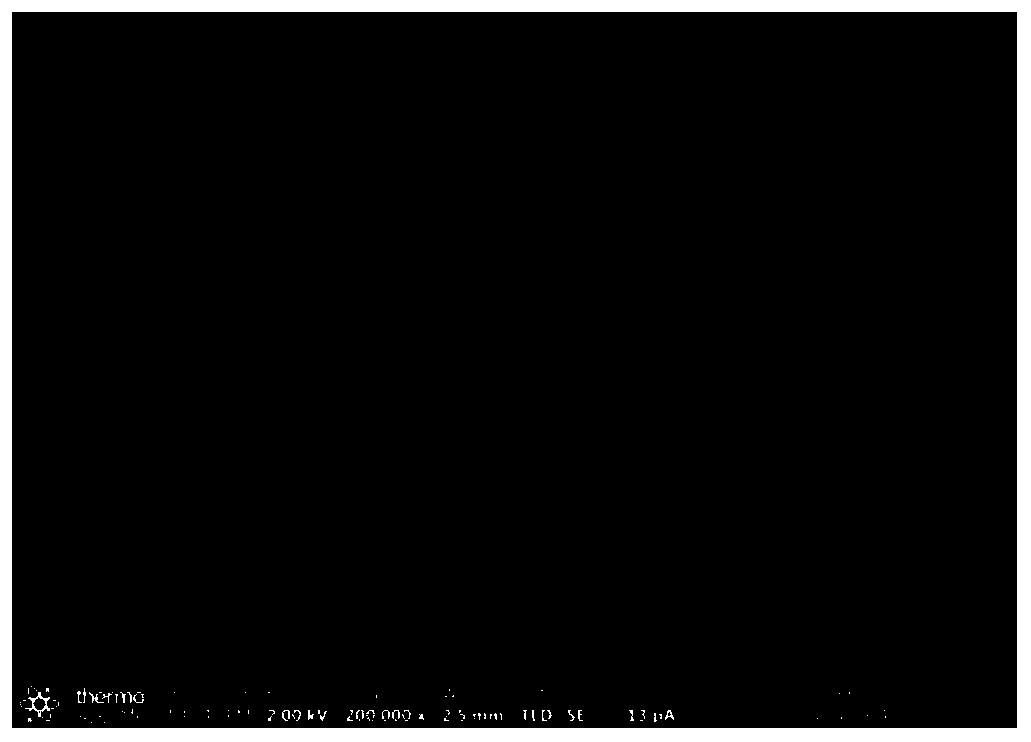Light-adjustable room-temperature phosphorescent carbon dot material, preparation method and applications thereof
A room temperature phosphorescence and carbon dot technology, which is applied in luminescent materials, fluorescence/phosphorescence, material analysis by optical means, etc., can solve the problems of cumbersome experimental steps, lack of phosphorescence carbon dots, and single material form, and achieves simple operation steps, The effect of universality and long phosphorescence lifetime
- Summary
- Abstract
- Description
- Claims
- Application Information
AI Technical Summary
Problems solved by technology
Method used
Image
Examples
Embodiment 1
[0043] Weigh 7.5g of potassium nitrate and 2.5g of sodium chloride powder (melting temperature is 350 ℃) into a sample bottle, add distilled water, stir well, then vacuum freeze-dry, and grind to obtain a uniform mixed salt system. Weigh 0.5 g of 1,2,4-triaminobenzene, grind it and the mixed salt system, place it in a crucible, heat it up to 350 °C at a heating rate of 10 °C in a muffle furnace, and heat it at 350 °C. Incubate for 3 hours, and then cool down to room temperature to obtain carbon dots with room temperature phosphorescence.
[0044] The scanning electron microscope image of the obtained powder is as follows figure 1As shown, the obtained material is oval or rod-shaped, and the size is about 50 nm. The powder was dispersed in acetone and tested by transmission electron microscopy and the results were as follows figure 2 , indicating that the carbon quantum dots with a diameter of about 2-3 nm are dispersed in a molten salt matrix of about 50 nm, indicating that...
Embodiment 2
[0048] Weigh 7.5g of potassium nitrate and 2.5g of sodium chloride powder (melting temperature is 350 ℃) into a sample bottle, add distilled water, stir well, then vacuum freeze-dry, and grind to obtain a uniform mixed salt system. Weigh 0.5g of citric acid, grind it with the mixed salt system, place it in a crucible, and keep it in a muffle furnace at a heating rate of 10°C at 350°C for 3 hours. When the temperature is cooled to room temperature, it has a Room-temperature phosphorescent carbon-based nanomaterials. The result is as Figure 8 As shown, the as-prepared material has an optimum emission at 477 nm for fluorescence and at 557 nm for phosphorescence (at an optimum excitation wavelength of 400 nm). The powder is white under a fluorescent lamp. Under a 395nm UV lamp, the obtained powder exhibits green fluorescence. When the UV lamp is turned off, the phosphorescence of the powder changes from green to yellow.
Embodiment 3
[0050] Weigh 7.5g of potassium nitrate and 2.5g of sodium chloride powder (melting temperature is 350 ℃) into a sample bottle, add distilled water, stir well, then vacuum freeze-dry, and grind to obtain a uniform mixed salt system. Weigh 0.5g of ethylenediaminetetraacetic acid, grind it and the mixed salt system, place it in a crucible, and keep it in a muffle furnace at a heating rate of 10°C at 350°C for 3 hours. When the temperature is cooled to room temperature, That is, carbon-based nanomaterials with room temperature phosphorescence are obtained. The result is as Figure 9 As shown, the as-prepared material has an optimum emission of fluorescence at 432 nm and an optimum emission of phosphorescence at 516 nm (at an optimum excitation wavelength of 365 nm). The powder is white under a fluorescent lamp. Under a 365nm UV lamp, the obtained powder exhibits blue fluorescence. When the UV lamp is turned off, the phosphorescence of the powder changes from green to yellow.
PUM
| Property | Measurement | Unit |
|---|---|---|
| particle diameter | aaaaa | aaaaa |
| particle size | aaaaa | aaaaa |
| size | aaaaa | aaaaa |
Abstract
Description
Claims
Application Information
 Login to View More
Login to View More - R&D
- Intellectual Property
- Life Sciences
- Materials
- Tech Scout
- Unparalleled Data Quality
- Higher Quality Content
- 60% Fewer Hallucinations
Browse by: Latest US Patents, China's latest patents, Technical Efficacy Thesaurus, Application Domain, Technology Topic, Popular Technical Reports.
© 2025 PatSnap. All rights reserved.Legal|Privacy policy|Modern Slavery Act Transparency Statement|Sitemap|About US| Contact US: help@patsnap.com



